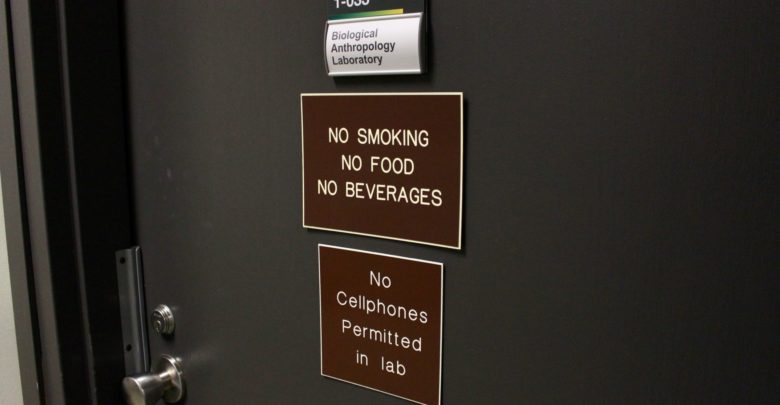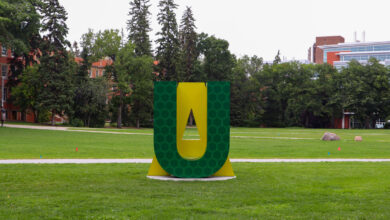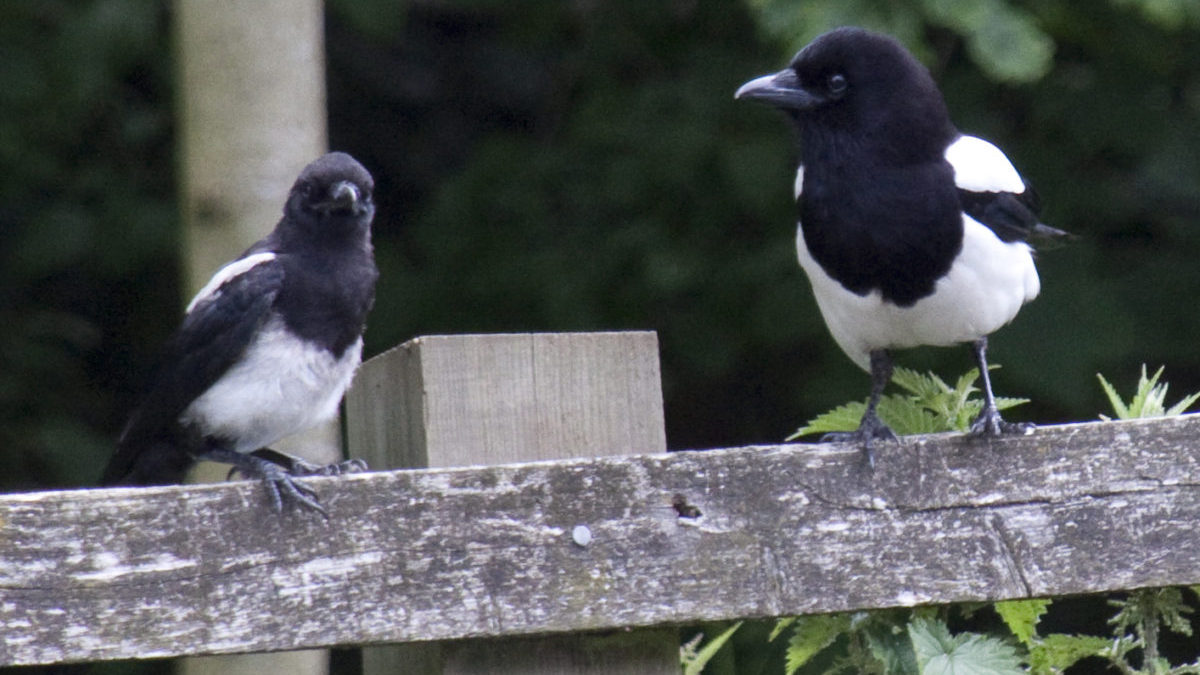 Emily Williams
Emily WilliamsIn the last couple of years, repatriation has been on the forefront of many anthropologists’ minds. As decolonization has become standard practice in modern anthropology, many universities and museums have had to come to terms with the history of the discipline and their institutions. The U of A is no exception.
The University of Alberta is known for its museums, and is home to priceless artifacts, with many used for teaching. In the anthropology department, the osteology collection has over 10,000 bones used to teach undergraduate students about human anatomy. Most of the collection consists of adults, but there are some infants and children. In upper-level classes, you have the opportunity to study the juvenile remains, as well as plastic replicas of the more fragile specimens.
I reached out to the curator of the osteology collection, Tonya Simpson, for an interview in October. Despite being new to the position, she was initially very open about it, telling me she would try and answer any of my questions. In a later email, she canceled the interview, citing that her and her colleagues felt she needed to study the collection more.
I reached out once more in November, letting Simpson know it was for a print edition of The Gateway. She initially agreed to do an interview, but when I declined to provide the interview questions in advance, she changed her mind. As an alternative, I offered to include written comments from her in response to a few questions over email — this too was declined.
“At this point, I just wouldn’t have the answers to these questions,” she said.
The university also declined to comment, saying they were “unable to offer comment on an opinion piece.”
Instead, I reached out to Lesley Harrington, a biological anthropologist and associate professor at the U of A. Through email, she answered a list of questions that I had.
When you take a class that allows you to access the osteology collection, professors will go over a document with the class about its history. The statement was written by many key figures in biological anthropology at the U of A, such as Sandra Garvie-Lok, Pamela Mayne Correia, and Harrington herself. It talks about where the collection comes from, why the department continues to use it, and the benefits students can gain from it.
The document echoes popular sentiment held by the department — even though it’s wrong to have the human remains, it’s too good of an opportunity to pass up. In her email to me, Harrington expressed this, as well.
“As with the teaching of anatomy in clinical education, it is widely held that the best opportunity for learning about the human skeleton comes from handling real bone rather than physical or virtual models,” she said.
I asked Harrington if it was standard practice to allow undergraduate students to learn from human remains in their labs. Despite each department being unique in its teachings and the courses offered, biological anthropology in Canada can be traced back to a rather small group of highly trained individuals who started the first programs, she said. In her experience, it’s common for departments that are more established to have teaching osteology collections. For those that are much smaller, they have to make do with what resources they have access to.
That is why the U of A continues to teach with the collection, despite the fact that doing so does not “align with current ethical standards for anatomical study collections.”
Like most institutions who owe their start to colonization, the U of A has a repatriation policy. When relatives of those in the collection want their family members back, they can request their return from the U of A. However, for the osteology collection, this is largely useless. The remains used to teach students are largely anonymous, with only a vague idea of their background.
According to the anthropology department’s statement, much of the collection was obtained in the 1970s from Carolina Biological Supply Company. The majority of the individuals are from Calcutta, India, but a few are from Russia and China. Those obtained from India were “unclaimed bodies prepared for use in medical teaching,” the document says. At the time, they were exported according to India’s laws.
In her email, Harrington further specified that the individuals were purchased. She also pointed out that most of the individuals died in the early 20th century and their appearance is consistent with having never been buried.
As well, some of the remains are exam bones, meaning that they’re just parts of a bone instead of a complete specimen.
This is seen in lab portions of human osteology classes, where you’re required to know all the bones, and be able to identify them from a limited set of characteristics. You might just have a distal end of a fibula or a part of the occipital bone from a skull.
All of these facts make it tricky to repatriate the teaching collection. How can the university give the bones back when they don’t know who they belong to?
Just because their identities are unknown, and you are the one who purchased them, doesn’t mean they belong to you. These are real people — while they shouldn’t belong to anyone, they certainly don’t belong to the people who purchased them, even if it was commonplace at the time. At the very least, they should be in their home country.
“As the individuals represented in the collection are unknown, there is currently no practical solution for meaningfully repatriating their remains,” the document said.
Unfortunately, those who decide what meaningful repatriation is, in this case, are also the ones who continue to benefit from having the collection.
As well, despite repatriating the remains in the collection being “impractical,” it is necessary. Instead, maybe the university should provide India, the origin of most of the collection, the opportunity to decide what meaningful repatriation means. It could be burying the remains there, and finally allowing them to rest. Or, it could be allowing a university in Calcutta to employ the remains in their own departments.
It’s absolutely true that the collection provides invaluable knowledge to students. Maybe giving students in India the chance to learn from them would be a good first step in reconciliation.
There have been strides to treat the individuals in the collection with the respect they deserve, however. When I was a student in the class, we were told that photographs of the remains were strictly forbidden. Harrington also talked about teaching respectful language to students in order to give dignity to those in the collection.
“The remains represent once living people. Therefore, we think it is important to acknowledge this by referring to the remains as those of an ‘individual’ or a ‘person’ — rather than a ‘specimen.’”
In all her years teaching with the collection, Harrington says she has never witnessed a student acting disrespectfully to the individuals.
However, the fact remains that the U of A has a history that is rooted in colonialism, and continues to benefit from that history today. By teaching with the human remains sourced from other colonized countries, the anthropology department is just continuing that cycle.
“We recognize that there are parts of the collection that exist due to the exploitation of vulnerable individuals, most of whom lived in poverty and none of whom consented to this use of their remains,” the document reads.
“At the same time, though, the remains and their history must serve as a potent reminder of our ethical responsibilities as anthropologists.”
Unbeknownst to the anthropology department, the collection doesn’t need to be in use for there to be a reminder of colonization. In anthropology, colonization is everywhere. By ignoring this, the department shows how tone-deaf and unaware it truly is.
The anthropology department at the U of A prides itself on its acknowledgment of the colonial past that built, and continues to uphold, modern anthropology. In every anthropology class I’ve ever taken, my professors have talked at length about the history of anthropology, and the importance of acknowledging the colonial roots that continue to shape our studies. But, their prolonged use of the osteology collection shows they’re not entirely ready to completely separate themselves from their colonial past.
When you first start learning with the collection in a more hands-on way, it’s easy to forget their individuality and humanity. Despite the department’s best effort to ensure that the remains are respected, it’s hard to see them as people when you’re in the lab. Even when you’re holding them, you see them as ‘specimens,’ not individuals. For me, it wasn’t until we started learning about the skull that I realized I was holding a formerly living, breathing person.
As an anthropology student, I’m very familiar with the osteology collection. I’ve seen them in classes, and I’ve studied them personally. I’ve benefited from studying them, and have a better understanding of human anatomy and osteology as a result. However, I never should have had access to them in the first place.




